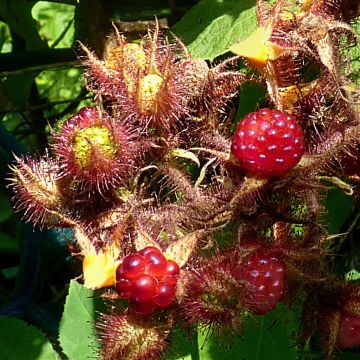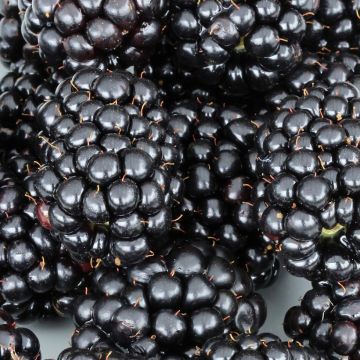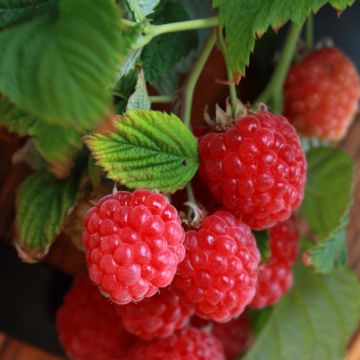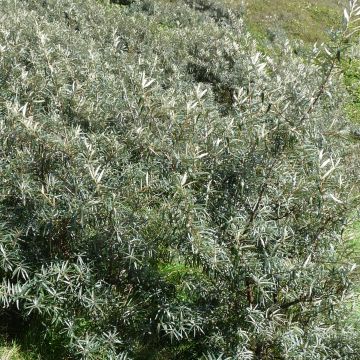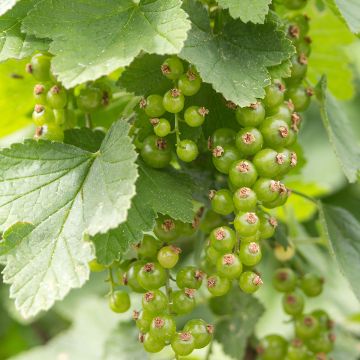

Mûre Buckingham Tayberry Bio en pot de 1,5L/2L
Organic Buckingham Tayberry
Rubus fruticosus x idaeus Buckingham® Tayberry
This item cannot be shipped to the selected country
Delivery charge from €5.90
Delivery to Corse prohibited
More information
Schedule delivery date,
and select date in basket
This plant carries a 6 months recovery warranty
More information
We guarantee the quality of our plants for a full growing cycle, and will replace at our expense any plant that fails to recover under normal climatic and planting conditions.
From €5.90 for pickup delivery and €6.90 for home delivery
Express home delivery from €8.90.
Delivery to Corse prohibited: UE law prohibits the import of this plant from mainland France to Corse as part of the fight against Xylella fastidiosa. Please accept our sincere apologies.
More information
Description
The Buckingham® Organic Tayberry is a recent variety of tayberry (raspberry-blackberry cross) derived from organic agriculture. It is a sarmentose perennial plant, almost devoid of thorns, with long flexible branches and rapid growth. It produces very large elongated fruits, dark red-black when ripe in July-August, with a very fine taste, a mix of blackberry and raspberry. This variety is self-fertile, highly productive, vigorous, and very hardy. Undoubtedly, this little fruit will surprise food lovers. Plant it in ordinary, well-drained soil, in full sun or partial shade.
The Buckingham® Tayberry belongs to the large Rosaceae family. The tayberry is a crossbreed between a raspberry and a wild bramble*. The 'Buckingham' cultivar has a flexible and spreading habit, with branches that can reach 2 metres (7 feet) in length and a stump that can occupy 2 metres (7 feet) of ground. The foliage is deciduous, falling in autumn. It is a vibrant green colour, composed of entire, wavy, and toothed leaves with visible veins, very similar to raspberry leaves. The stems are almost thornless, with a few small inherited thorns from its parents. They only live to bear fruit (2 years) and are replaced over time by shoots coming from the stump. Production reaches its normal level in the third year after planting. The abundant and honey-producing flowering displays numerous small white flowers, 1.5 cm (1in) in diameter, grouped in clusters. It occurs in May. The fruits that form are made up of drupes clustered on the receptacle, adhering to it. They are large, elongated, measuring up to 5cm (2in) in length, initially appearing red and then becoming purple-black when ripe in July-August. They should be harvested when fully ripe, as they are both sweet and tangy, very well-balanced, combining the fragrance of raspberry and blackberry. The fruits can be consumed fresh after picking, or frozen, and are perfect for making jams.
The Buckingham® Tayberry produces very long flexible branches that must be trained (on a trellis, fence, or lattice). Hardy and easy to grow, it thrives in ordinary soil, with a preference for fertile, well-drained, and fresh soil. It will be perfectly suited to the shelter of a sunny or partially shaded wall, highlighting the bare wood of the flexible branches in winter. Tayberries, like raspberries, contain two specific sugars, levulose and fructose, and very little sucrose, making them low in energy. The fruits also contain ellagic acid, tannins, vitamin C, and are a good source of potassium.
*This crossbreeding was first achieved in 1881 in Santa Cruz by James Harvey Logan, who named his creation the 'Loganberry'. There are several varieties of these hybrids. They exhibit growth characteristics similar to those of blackberries: great vigour, bushy habit; but the fruits are closer to raspberries, albeit darker, larger, and more elongated.
Report an error about the product description
Organic Buckingham Tayberry in pictures






Plant habit
Fruit
Flowering
Foliage
Botanical data
Rubus
fruticosus x idaeus
Buckingham® Tayberry
Rosaceae
Cultivar or hybrid
Other Blackberry bush
Planting and care
The Buckingham Tayberry prefers deep, fertile, not too dry to moist soils, but it is a low-maintenance plant that will adapt to any ordinary soil that is not too dry. This bramble fruits in the sun, in partial shade, or even in shade, but the fruits will be of lower quality. When grown in a pot, it can be planted all year round. However, it is preferable to plant it in the garden in autumn, from September to November. Dig a hole much larger than the root system. Scratch the root ball with a slightly sharp tool to loosen the root mass and promote establishment. Place the bush in the hole without burying it too deep. Water thoroughly to compact the soil and remove air around the roots. It will be necessary to ensure that the plant does not lack water in the first year after planting. An application of organic fertiliser is beneficial at the start of growth. Train the new shoots as they grow.
Planting period
Intended location
Care
This item has not been reviewed yet - be the first to leave a review about it.
Berries
Haven't found what you were looking for?
Hardiness is the lowest winter temperature a plant can endure without suffering serious damage or even dying. However, hardiness is affected by location (a sheltered area, such as a patio), protection (winter cover) and soil type (hardiness is improved by well-drained soil).

Photo Sharing Terms & Conditions
In order to encourage gardeners to interact and share their experiences, Promesse de fleurs offers various media enabling content to be uploaded onto its Site - in particular via the ‘Photo sharing’ module.
The User agrees to refrain from:
- Posting any content that is illegal, prejudicial, insulting, racist, inciteful to hatred, revisionist, contrary to public decency, that infringes on privacy or on the privacy rights of third parties, in particular the publicity rights of persons and goods, intellectual property rights, or the right to privacy.
- Submitting content on behalf of a third party;
- Impersonate the identity of a third party and/or publish any personal information about a third party;
In general, the User undertakes to refrain from any unethical behaviour.
All Content (in particular text, comments, files, images, photos, videos, creative works, etc.), which may be subject to property or intellectual property rights, image or other private rights, shall remain the property of the User, subject to the limited rights granted by the terms of the licence granted by Promesse de fleurs as stated below. Users are at liberty to publish or not to publish such Content on the Site, notably via the ‘Photo Sharing’ facility, and accept that this Content shall be made public and freely accessible, notably on the Internet.
Users further acknowledge, undertake to have ,and guarantee that they hold all necessary rights and permissions to publish such material on the Site, in particular with regard to the legislation in force pertaining to any privacy, property, intellectual property, image, or contractual rights, or rights of any other nature. By publishing such Content on the Site, Users acknowledge accepting full liability as publishers of the Content within the meaning of the law, and grant Promesse de fleurs, free of charge, an inclusive, worldwide licence for the said Content for the entire duration of its publication, including all reproduction, representation, up/downloading, displaying, performing, transmission, and storage rights.
Users also grant permission for their name to be linked to the Content and accept that this link may not always be made available.
By engaging in posting material, Users consent to their Content becoming automatically accessible on the Internet, in particular on other sites and/or blogs and/or web pages of the Promesse de fleurs site, including in particular social pages and the Promesse de fleurs catalogue.
Users may secure the removal of entrusted content free of charge by issuing a simple request via our contact form.
The flowering period indicated on our website applies to countries and regions located in USDA zone 8 (France, the United Kingdom, Ireland, the Netherlands, etc.)
It will vary according to where you live:
- In zones 9 to 10 (Italy, Spain, Greece, etc.), flowering will occur about 2 to 4 weeks earlier.
- In zones 6 to 7 (Germany, Poland, Slovenia, and lower mountainous regions), flowering will be delayed by 2 to 3 weeks.
- In zone 5 (Central Europe, Scandinavia), blooming will be delayed by 3 to 5 weeks.
In temperate climates, pruning of spring-flowering shrubs (forsythia, spireas, etc.) should be done just after flowering.
Pruning of summer-flowering shrubs (Indian Lilac, Perovskia, etc.) can be done in winter or spring.
In cold regions as well as with frost-sensitive plants, avoid pruning too early when severe frosts may still occur.
The planting period indicated on our website applies to countries and regions located in USDA zone 8 (France, United Kingdom, Ireland, Netherlands).
It will vary according to where you live:
- In Mediterranean zones (Marseille, Madrid, Milan, etc.), autumn and winter are the best planting periods.
- In continental zones (Strasbourg, Munich, Vienna, etc.), delay planting by 2 to 3 weeks in spring and bring it forward by 2 to 4 weeks in autumn.
- In mountainous regions (the Alps, Pyrenees, Carpathians, etc.), it is best to plant in late spring (May-June) or late summer (August-September).
The harvesting period indicated on our website applies to countries and regions in USDA zone 8 (France, England, Ireland, the Netherlands).
In colder areas (Scandinavia, Poland, Austria...) fruit and vegetable harvests are likely to be delayed by 3-4 weeks.
In warmer areas (Italy, Spain, Greece, etc.), harvesting will probably take place earlier, depending on weather conditions.
The sowing periods indicated on our website apply to countries and regions within USDA Zone 8 (France, UK, Ireland, Netherlands).
In colder areas (Scandinavia, Poland, Austria...), delay any outdoor sowing by 3-4 weeks, or sow under glass.
In warmer climes (Italy, Spain, Greece, etc.), bring outdoor sowing forward by a few weeks.

































